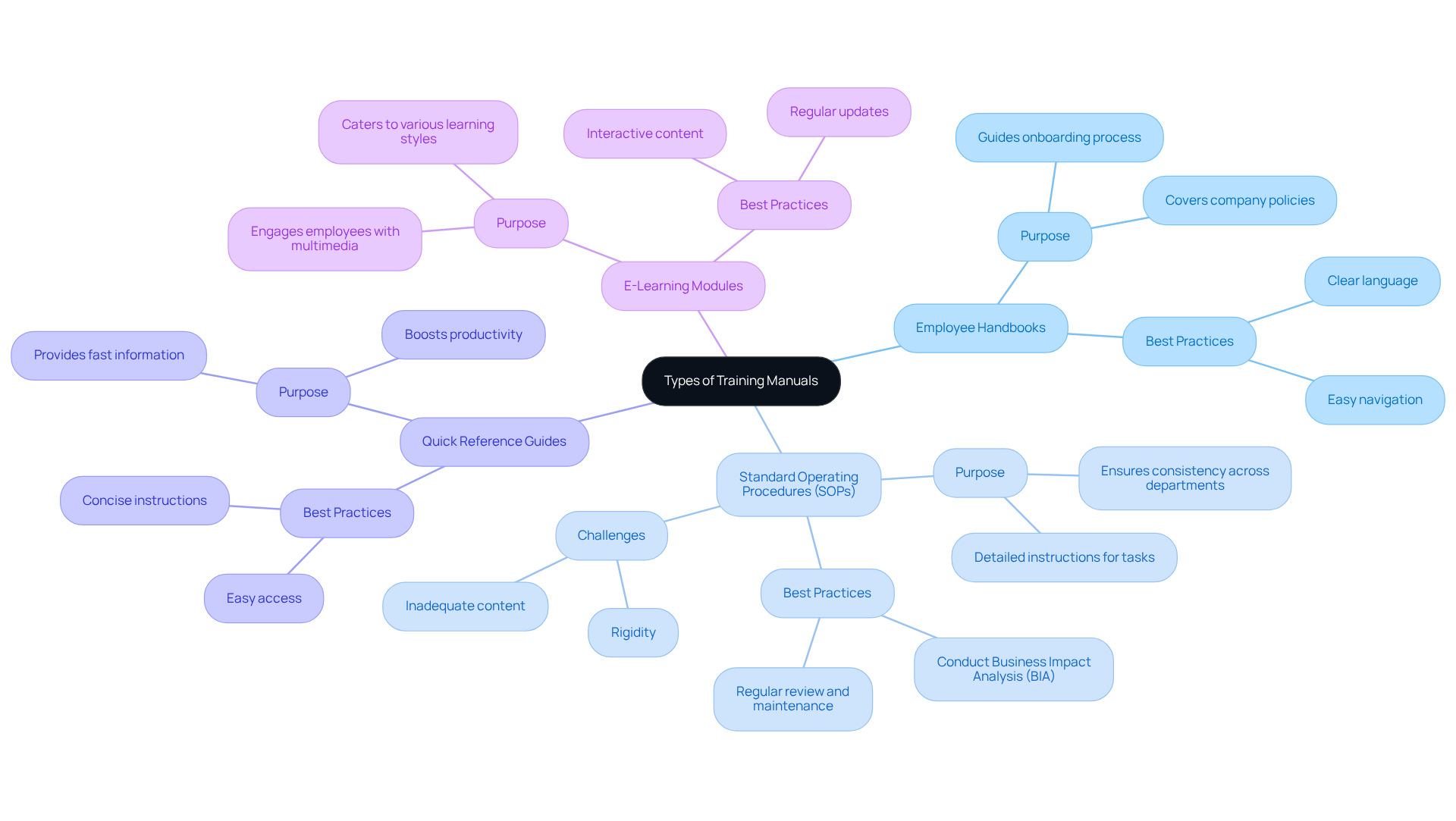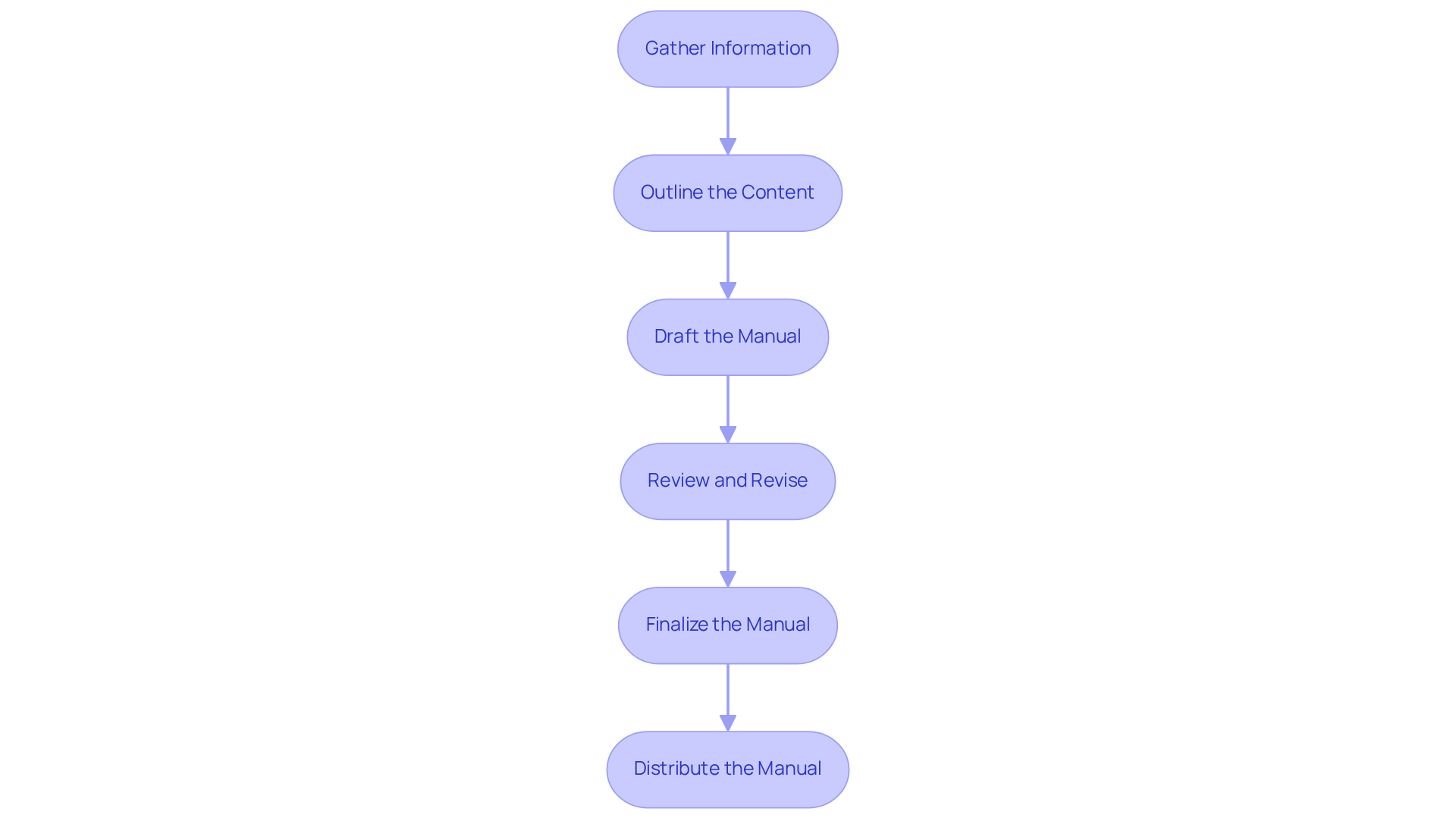
Automation and Documentation
|
July 15, 2025
|
Creating Training Manual: A Step-by-Step Approach for Operations Managers
Overview
You might be wondering how to create effective training manuals that truly make a difference. Well, this article lays out a systematic approach just for operations managers like you! It highlights the importance of:
- Defining the manual's purpose
- Choosing the right types
- Following a structured development process
And guess what? There's solid evidence that well-crafted manuals can boost onboarding efficiency and enhance employee performance. Plus, by regularly updating them and incorporating team feedback, you can keep those manuals fresh and engaging. So, let's dive into how you can make your documentation work for you!
Key Highlights:
- Defining the purpose of a training manual is crucial for effectiveness, focusing on targeted skills and intended audience.
- Instructional guides can significantly speed up onboarding and improve employee performance.
- Types of training manuals include Employee Handbooks, Standard Operating Procedures (SOPs), Quick Reference Guides, and E-Learning Modules.
- A systematic approach to creating training manuals involves gathering information, outlining content, drafting, reviewing, finalising, and distributing the manual.
- Regular maintenance of training manuals is essential, with scheduled reviews and updates to keep content relevant.
- Encouraging team feedback and communicating changes enhances engagement and retention among employees.
Introduction
Creating an effective training manual is super important for operations managers who want to boost employee performance and make onboarding a breeze. You might be wondering, why is a well-structured manual so crucial? Well, it not only acts as a go-to resource for new hires but also helps existing staff stay in sync with company policies and procedures.
But here's the catch: many organizations struggle with figuring out the manual's purpose and keeping it fresh as workplace dynamics change.
So, what can operations managers do to put together a comprehensive training manual that caters to their team's diverse needs while promoting a culture of continuous learning and development?
Let's explore that together!
Define the Purpose of a Training Manual
Creating a training manual requires clearly defining its purpose to be effective. You might be wondering:
- What specific skills or knowledge should employees pick up from this manual?
- Who’s the intended audience—new hires, current staff, or maybe both?
- What processes or tasks will the guide cover?
Answering these questions will really help you create a targeted guide that meets your organization’s needs. For instance, if the guide is meant for onboarding new employees, it should definitely include essential company policies, procedures, and role-specific instructions. This organized approach not only speeds up the onboarding process but also boosts staff performance and retention. Did you know that studies suggest instructional guides can help new staff become effective in half the time compared to those who don’t have such resources? Plus, companies that invest in corporate development see a whopping 218% higher income per employee, which really highlights the importance of having clearly defined educational objectives. Take Netflix's Culture Code, for example; it succinctly communicates core principles and expectations, helping new hires quickly grasp the company's values.
Now, let’s dive into how you can simplify the development and revision of your instructional guides with SowFlow's instant documentation solution. With features like invoking the knowledge of your documentation with just a single command, you can ensure that your guides stay relevant and effective in today’s ever-changing business landscape. And don’t forget, instructional guides should be reviewed and refreshed at least once a year to keep them efficient. By clarifying the aim of your training guide and leveraging SowFlow's capabilities, you’re laying the groundwork for creating a training manual that promotes efficiency and consistency across your training programs.

Explore Different Types of Training Manuals
Training manuals come in all shapes and sizes, each designed to meet specific instructional needs. You might be wondering what types there are and how they can help you.
-
Employee Handbooks are comprehensive guides that cover company policies, culture, and procedures. They serve as a foundational resource for both new hires and existing employees. Think of them as your go-to guide for onboarding, helping everyone get on the same page with organizational values and expectations.
-
Then we have Standard Operating Procedures (SOPs). These are your detailed, step-by-step instructions for specific tasks or processes. They’re essential for keeping things consistent across departments and minimizing operational risks. Did you know that effective SOPs can actually save time and ensure consistency in how tasks are executed? However, creating SOPs can come with its own set of challenges, like rigidity or inadequate content. Organizations need to tackle these issues to keep things running smoothly. Plus, it’s a good idea to conduct a business impact analysis (BIA) after rolling out a new SOP to spot any potential risks and make sure it doesn’t lead to business losses.
-
Now, let’s talk about Quick Reference Guides. These handy little documents provide easy-to-follow instructions for when you need information fast. They’re perfect for reducing the time spent searching for answers and boosting productivity by putting essential information right at your fingertips.
-
And don’t forget about E-Learning Modules! These interactive online resources engage employees with multimedia content and evaluations. They can be a game-changer for improving retention and understanding, catering to various learning styles.
Choosing the right type of instructional manual is essential when creating training manuals to achieve your educational goals. For instance, when you need thorough guidance for complex procedures, SOPs are often your best bet. Best practices for creating training manuals include establishing a common style and format, using clear language, and making navigation easy with a table of contents. It’s also smart to keep all SOPs in one place, ideally online, for easy access and updates. By picking the right format and following these best practices, organizations can ensure their educational materials are not just informative but also engaging and easy to navigate.

Follow a Step-by-Step Process to Create Your Training Manual
Creating a training manual is all about a systematic approach that boosts clarity and usability. So, how do you make sure your manual is both comprehensive and user-friendly? Let’s break it down:
-
Gather Information: You might be wondering where to start. Begin by collecting existing documentation, chatting with subject matter experts, and observing processes in action. This foundational step ensures your guide is rooted in real-world practices.
-
Outline the Content: Next up, create a structured outline tailored for your document's purpose and audience. Research shows that guides with clear outlines significantly improve retention and comprehension—studies even suggest that structured outlines can enhance learning outcomes by up to 50%! This makes it easier for users to navigate the material.
-
Draft the Manual: Now, let’s dive into writing. Aim for clear and concise content, using bullet points, headings, and visuals to boost readability. This approach not only aids understanding but also keeps readers engaged. For example, organizations like ABB have seen a 4x gain in efficiency by using structured documentation processes.
-
Review and Revise: Once you have a draft, share it with stakeholders for feedback. You know what they say: diverse viewpoints can lead to valuable insights and enhancements, ensuring your guide meets everyone’s needs. The National Rural Electric Cooperative Association points out that quick and easy content merging can really cut down the time spent on document creation.
-
Finalize the Manual: Time to polish it up! Format the document for consistency and clarity, focusing on visual appeal. A well-structured guide is more likely to be used efficiently by staff. Plus, integrating smart calculations and business rules—like those seen in healthAlliance implementations—can further elevate your documentation quality.
-
Distribute the Manual: Finally, share the completed version with employees and provide guidance on its proper use. This step is crucial for ensuring that the guide serves its intended purpose. Choice Legal Group emphasizes that proper instruction on documentation tools can lead to significant boosts in operational efficiency.
By following this organized procedure, creating training manuals can help you not only inform but also empower your team, ultimately enhancing operational efficiency and shortening onboarding time.

Maintain and Update Your Training Manual Regularly
To keep your training manual effective, why not set up a systematic review process?
First off, let’s talk about scheduling reviews. You might want to set a consistent timeline for checking in on the manual, maybe quarterly or bi-annually. Frequent evaluations are key! Did you know that 94% of staff say they’d stick around longer at a company that invests in their professional growth? That really highlights how important it is to have up-to-date development resources.
Next, think about requesting input. Actively encourage your team to share their thoughts on how usable and relevant the guide is. This feedback loop is super important—77% of employees believe that personalized development boosts their engagement and retention.
Now, let’s dive into updating content. It’s crucial to revise the manual to reflect any changes in processes, policies, or technology. Ongoing education has become a must in today’s workplace, and keeping your instructional materials fresh is essential to meet these expectations. Noah Young points out that "Ongoing learning opportunities make 76% of workers more likely to remain with their current employer," which really emphasizes the link between effective development resources and staff retention.
And don’t forget to communicate changes! Make sure to notify your team about updates and provide guidance on any new procedures. Effective communication keeps everyone on the same page with the latest practices, fostering a culture of collaboration and knowledge sharing.
By consistently maintaining and updating your instructional manual, as well as creating a training manual, you’re not just ensuring it remains a valuable resource, but you’re also enhancing operational efficiency and supporting employee development. Plus, using a documentation system like SowFlow can make this process smoother, helping you manage and update training materials effectively.

Conclusion
Creating an effective training manual is super important for boosting operational efficiency and employee performance. You might be wondering how to make your manual really shine. By clearly defining its purpose, exploring different types of training manuals, and following a systematic approach to development, you can ensure that your instructional materials are not just informative but also engaging and user-friendly. This structured methodology lays a solid foundation for successful onboarding and ongoing staff development.
Throughout this article, we’ve discussed some key insights. For instance, tailoring training manuals to specific audiences is crucial. Plus, different manual types, like SOPs and e-learning modules, each have their own benefits. And let’s not forget the necessity of keeping these resources up-to-date. Each step in the creation process, from gathering information to distributing the final manual, contributes to a comprehensive guide that empowers employees and fosters a culture of continuous learning.
Ultimately, the significance of a well-structured training manual can’t be overstated. It’s a vital tool for onboarding new employees and retaining existing staff by investing in their professional growth. By prioritizing the creation and maintenance of effective training materials, you can enhance operational efficiency, improve employee satisfaction, and drive overall success. So, why not embrace the opportunity to develop a robust training manual that meets the evolving needs of your workforce and propels your organization forward?
Frequently Asked Questions
What is the purpose of a training manual?
The purpose of a training manual is to clearly define the skills or knowledge that employees should acquire, identify the intended audience (new hires, current staff, or both), and outline the processes or tasks covered in the guide.
Who should the training manual be targeted towards?
The training manual should be targeted towards the intended audience, which can include new hires, current staff, or both, depending on the specific goals of the manual.
What should be included in a training manual for onboarding new employees?
A training manual for onboarding new employees should include essential company policies, procedures, and role-specific instructions to help them acclimate quickly and effectively.
How can a training manual impact employee performance and retention?
An organized training manual can speed up the onboarding process, boost staff performance, and improve retention rates by providing clear guidance and expectations for new hires.
What are the benefits of having instructional guides for new employees?
Studies suggest that instructional guides can help new staff become effective in half the time compared to those without such resources, and companies investing in corporate development see a 218% higher income per employee.
How often should instructional guides be reviewed and updated?
Instructional guides should be reviewed and refreshed at least once a year to ensure they remain relevant and effective.
What is SowFlow's role in developing training manuals?
SowFlow offers an instant documentation solution that simplifies the development and revision of instructional guides, allowing users to invoke knowledge with a single command to keep the guides up-to-date.
Can you provide an example of an effective training guide?
An example of an effective training guide is Netflix's Culture Code, which succinctly communicates core principles and expectations, helping new hires quickly understand the company's values.
👍
What others are liking
5 Steps to outline your ideal documentation structure
5 MINS READ
Where to start the your journey of mapping out your ideal documentation structure, aligning it with the very heartbeat of your organization?
Defining a winning level of detail in your process
3 MINS READ
What is too much detail, and what is too little? This article described in that winning level detail about what detail is enough.





